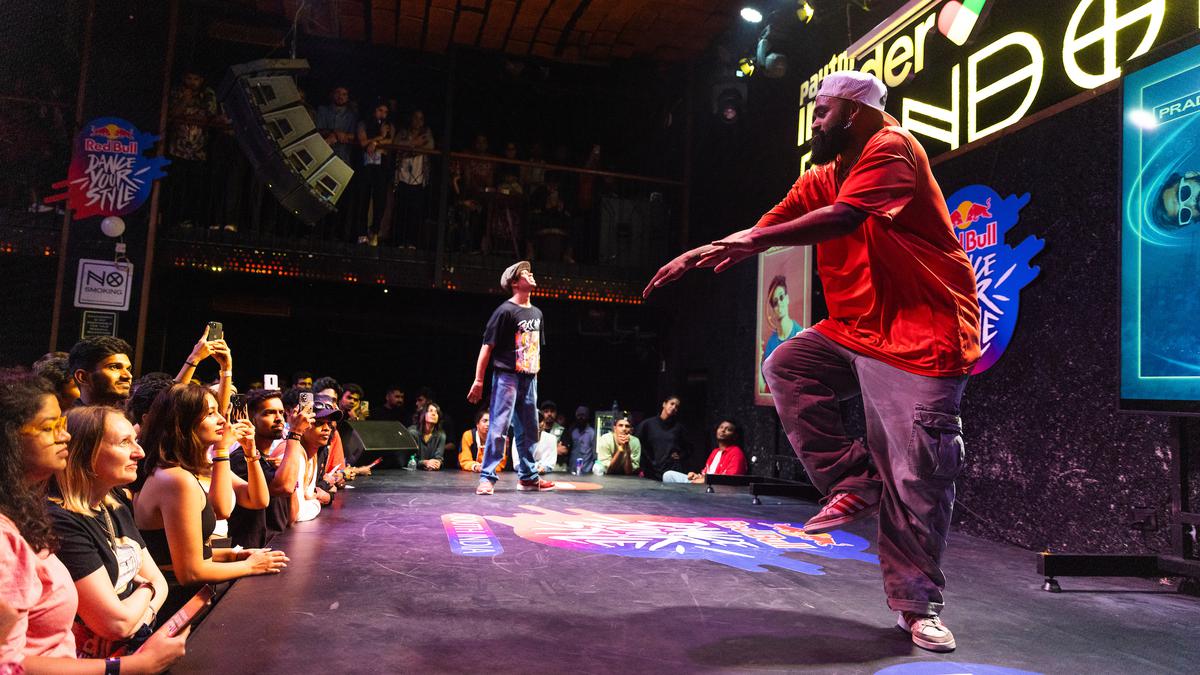
Bengaluru dancers talk about the rise of street dancing in India
It is close to 6 pm at Fandom at Gilly’s Redefined, Koramangala, Bengaluru. The atmosphere crackles with electric energy. The crowd swells, and the noise grows. Divya Easwaran, an Afro dancer from Bengaluru, faces off against Nivesh Kannan, a hip-hop dancer from Coimbatore.
And then, it happens.
The pulsating beats of Dhee and Arivu’s ‘Enjoy Enjaami’ fill the air, igniting the senses. As the lyrics go, “Thanniyil odum thavalaikki, kambali poochi thangachi” (for the frog that runs in the water, the caterpillar is sister), Divya unleashes her creativity. She springs forward with her hands mimicking a frog’s leap, her body fluid and graceful. The crowd erupts in a frenzy. She moves with the power and grace of a natural athlete, her movements fluid and effortless. She is clearly in her element, and her joy is contagious. Nivesh is no slouch either. He brings his unique style to the competition, blending hip-hop with elements of street dance. His moves are sharp and precise. The two dancers go head-to-head, trading moves and building on each other’s energy.
Thus commences Red Bull Dance Your Style India 2023 South Zone Final.
Catching on
“Four dancers from each of the four regions — North, South, East, and West — will compete in the Red Bull Dance Your Style 2023 India Finals. And the winner will represent India at the Red Bull Dance Your Style 2023 World Final in Germany later this year.
With the rise of social media and dance reality shows, street dancers in India have gained immense visibility and opportunities to showcase their talent on national and international stages. Influenced by a combination of local traditional dances, Bollywood, and international street dance styles, the Indian street dance scene has developed its own unique flavour and vibrancy. From the bustling streets of Mumbai to the cultural hubs of Delhi, Chennai, and Bengaluru, talented dancers showcase their skills, passion, and creativity in various forms, such as breaking, popping, locking, and freestyle.
ZuBoo, who runs the Ghetto Academy of Dance in Bengaluru, reflects on his journey and the evolution of street dancing in India. With a career spanning almost two decades, he has witnessed the transformation of the dance scene. “When I started in 2007, college events were a big thing. Every college had its own festival, and it became trendy to have a street dance segment, whether it was open style, hip-hop, crump, or any other style,” he says. “It kept evolving and changing over time. Bangalore was one of the first cities to introduce open-style dance battles. Eventually, this trend spread all over India.”
Pradeep K, who made it to the all-India finals last year, acknowledges the role of social media and other media outlets for the growth of street dancing in the country. But he also highlights the downside of this newfound visibility, expressing concern about the decline in authenticity. He explains, “With the increasing influence of media, there has been a noticeable decline in the authenticity of street dance. Some dancers and performers prioritize entertainment and capturing attention, compromising the true essence of the art form.”
Varsha Amarnath at Red Bull Dance Your Style India 2023 South Zone Final
| Photo Credit:
Special Arrangement
Making a change
ZuBoo reveals that his limited education, up to the 10th standard, stemmed from difficulties with English. The transition from the Kannada medium to English proved challenging, leading to the inability to pursue college. Feeling isolated without friends, the impact of videos and dancing sparked his desire to find personal entertainment and ultimately set him on the path of street dancing.
Divya Easwaran, a dance teacher, describes how street dancing positively impacted her personal growth. Initially, she shares, “I was more introverted, a good listener but not a talker. I rarely opened up.” However, through her immersion in street and club styles, she experienced a profound shift. Street dancing encouraged exploration and a departure from the rigid structures of traditional dance forms she had previously practised, such as Bharatanatyam. This newfound freedom allowed her to discover new ways of moving and cultivate a heightened sense of body awareness.
Moreover, street dancing played a significant role in expanding her expressive abilities and communication skills. Divya explains, “After street-dancing, I have become more expressive. I learned to communicate better.”
The dynamic and inclusive nature of streetdance encouraged her to break out of her introverted shell and embrace a more expressive and communicative self. “Because of street dance, I have gotten better at teaching too,” she adds.
Inclusive community
Dancers we spoke to at the event say the street dancing community in India celebrates diversity. Individuals are encouraged to express their unique styles and perspectives. The supportive and non-judgmental environment fosters a sense of belonging, creating a community where dancers can connect, collaborate, and grow.
Varsha Amarnath, a hip-hop dancer, highlights the supportive and inclusive nature of the street dancing community. “I appreciate the absence of gender bias and overpowering in this community. I never felt unsupported or overshadowed by the male dancers. They always stood behind me, empowering and encouraging me,” she says.
“While healthy competition exists, hip-hop is ultimately about love, peace, and unity, and they strive to hold onto these values regardless of the circumstances,” she adds.
Stay connected with us on social media platform for instant update click here to join our Twitter, & Facebook
We are now on Telegram. Click here to join our channel (@TechiUpdate) and stay updated with the latest Technology headlines.
For all the latest Entertainment News Click Here
For the latest news and updates, follow us on Google News.

